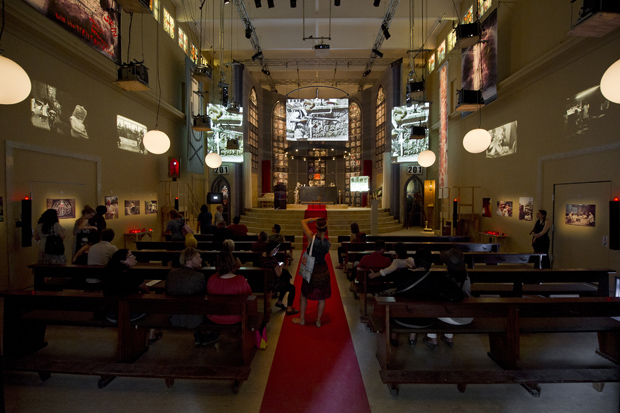
A Church of Fear vs. the Alien Within. Stage installation of the Fluxus-oratorio by Christoph Schlingensief in the German Pavilion, Altar view with film projection
Photo: (c) Roman Mensing, artdoc.de

A Church of Fear vs. the Alien Within. Stage installation of the Fluxus-oratorio by Christoph Schlingensief in the German Pavilion, Altar view with film projection
Photo: (c) Roman Mensing, artdoc.de
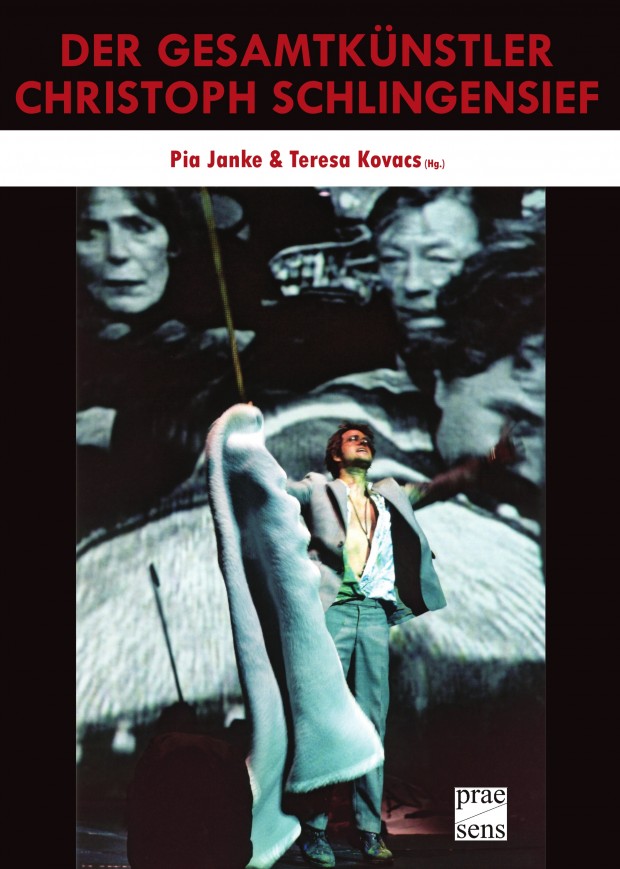
“The artist Christoph Schlingensief” recently published by the Praesens Verlag.
(ISBN 978-3-7069-0592-3)
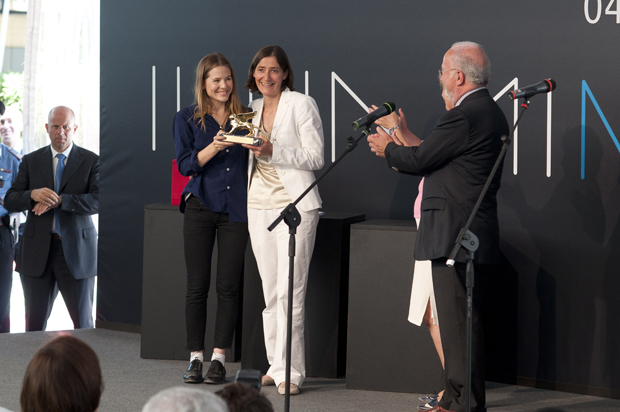
from left to right Aino Laberenz, Dr. Susanne Gaensheimer and Giorgio Orsoni, Photo: (c) Roman Mensing, artdoc.de
Working with Christoph Schlingensief when you’re an extreme rightist music producer?
Can it be done? Yes, it can be done! more…
“Christoph’s at the station, picking up the German Nazis.” So the press lady at Zurich’s
Schauspielhaus told me when I asked. The town was up in arms. A clear-cut case.
Typical. Hmm, but is that actually political? Those who wanted to know more precisely right away had failed to understand the moment. For the methodical examination of this sort of Schlingensief action amounted to a slowing of his creativity. Conversely: that was his permanent advantage. Because he permitted virtually no dissection of his work. That was how he always remained one step faster, ahead of those who thought they had finally come close, were finally right on it. Fiddlesticks. Because those moments were exactly when the twist came. Intuitive, hardly conceptual. And the mistaken belief of being on the same level with him thanks to “solid preparation,” that was even more wrong. Because then people needed to work off the ballast of their analytically approximate approaches when something altogether different was suddenly at issue. more…
I first met Christoph Schlingensief in 1987, when he cast me for his film Schafe in Wales
[Sheep in Wales]. He was still fairly unknown at the time, and at first glance he struck me
as a good-looking young middle-class man who had manners; every mother-in-law’s perfect dream. Yet behind the bourgeois façade lurked a great seducer, who would use his overwhelming charm to drive me into the craziest acts of self-abandonment, something I had not experienced since my time with Rainer Werner Fassbinder. After Fassbinder, with whom I spent a formative chapter of my life, from 1966 until his death in June 1981, and to whom I owe my very personal “Éducation sentimentale” in matters artistic as well as personal, working with Christoph now cast a similarly fascinating spell over me that mixed pleasure, fear, and curiosity. more…
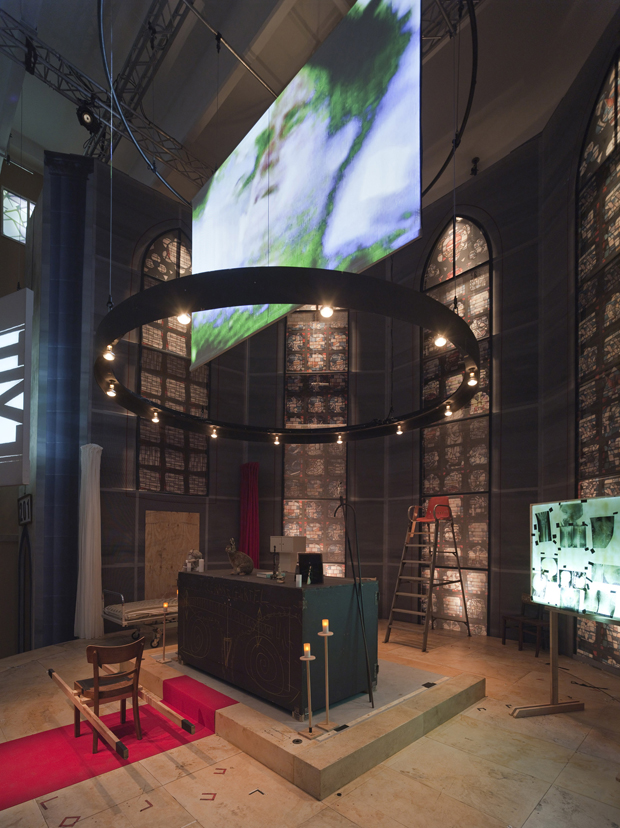
A Church of Fear vs. the Alien Within. Stage installation of Schlingensief`s Fluxus Oratory in the German Pavilion, Altar view with film projection. Photo: (c) Roman Mensing, artdoc.de
Jewish tombs in the twelfth century bear an emblem: a hare. In 1943, the symbol on the stones attracted the attention of Oberrottenführer Hartmut Mielke when his convoy was bulldozing Jewish cemeteries in central Germany so that the sites could be used for the construction of water tanks for fire trucks. The motif returns on tombstones from the seventeenth century: outstretched, prone hares “sleeping” or “slain.”
The Oberrottenführer, who was a dedicated local historian in his spare time, knew that this use contrasted with pagan depictions of hares in Celtic areas south of the Rhön Mountains, where hares are documented as appearing on sacrificial stone altars, but not on tombs. more…
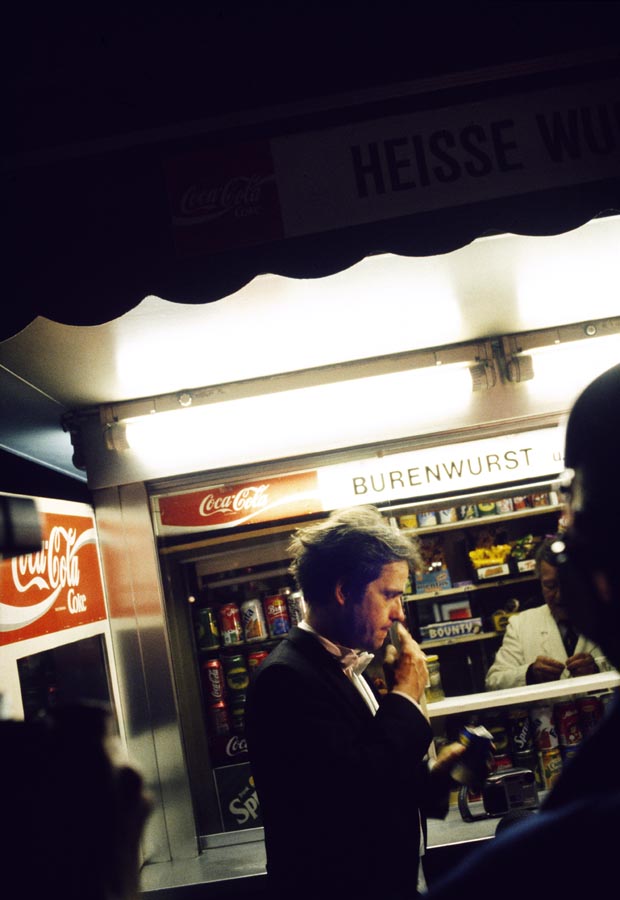
Christoph Schlingensief, Vienna 1998. Ball of Bad Taste. Sausage stand on Burgring, on the way between the Vienna Opera Ball and the Ball of Bad Taste © Peter Rigaud
Audio: Funeral
Terror 2000 (Intensive Station Germany), Germany, 1991-92, Directed by Christoph Schlingensief © Filmgalerie 451
Audio: At Table
100 Years Adolf Hitler (The Last Hour in the Fuhrerbunker), Germany, 1988-89, Directed by Christoph Schlingensief © Filmgalerie 451
Audio: The birth of Peter Panne
United Trash, Germany 1995-6, directed by Christoph Schlingensief © Filmgalerie 451
Audio: Theme Music (Helge Schneider)
Menu Total, Germany, 1985-86, Directed by Christoph Schlingensief © Filmgalerie 451
Audio: Border Control
The German Chainsaw Massacre (The First Hour of German Reunification), Germany, 1990, Directed by Christoph Schlingensief © Filmgalerie 451
Christoph Schlingensief pursued his idea of an opera village in Burkina Faso passionately. He imagined it as a “social sculpture,” a place of encounters and of dialogue. The Goethe-Institut supported Schlingensief in this project from the very beginning and continues to be committed to its development. In March, it began the “Conversations” series in Ouagadougou: workshops and discussions both in Africa and in Europe intended to support the realization of the opera village by providing creative stimuli and promoting inner-African dialogue. Now, on 2 June the second meeting will be held at the German Pavilion. Planned participants include Aino Laberenz, Susanne Gaensheimer, Francis Kéré, Chris Dercon and Simon Njami.
“The great power, however, rests in uncertainty, in the conviction that there are no solutions but only transformations and changes of form … that, to me, is not fatalism, it is a very big yes to life.” (Christoph Schlingensief)
Sunday, August 22, 2010, eight o’clock. Stunned by the news of your death that came yesterday—in the end, it was a surprise after all—and having slept only a few hours, I gaze into the morning sun, little big Scorpio brother, and find no way forward in my gloom. As though paralyzed, my mind keeps returning to something Bazon Brock made us take to heart: Death must be abolished, this damn mess must stop. Your fiftieth birthday was to be in a few weeks, the opera village project in Africa needed ongoing work, and of course you had hoped to make a personal appearance in Venice next year, where you were to design the German biennial pavilion. It would have been an honor for you to represent the nation and to irritate it as well, to challenge and provoke. more…
The provisional final performance of ‘Via Intolleranza II’ in Munich has already take place without Christoph Schlingensief, who had to leave for reasons of illness, and showed that it works – sadly – even without him. 90 concentrated minutes about the colonial situation in our heads, Schlingensief and his team included just as much as the pleasant Africans who are also in Europe looking for agents and careers. The framework is provided by a couple of remembered quotations from Nono’s ‘Intolleranza’, socially-aware avant-garde opera from distant times, where one still knew exactly where morality and progress were leading. The debate is as Gordian as it is fruitful, and after the dilemmas and their intractability have been repeatedly raised, examined and allowed to collapse in a compact performance, an African version of Bayreuth almost seems to be the logical consequence. At the end a Schlingensief double sits behind a pane of glass surrounded by a projected scratchy film, bangs hesitantly on the glass and asks the good old futile question of all artists like Mr Punch: “Another weird bit of performance art. Is anybody there?” Be warned: this is not a homage to Schlingensief, but a notable production!
Franz Wille
A production of the Festspielhaus Afrika gGmbH in co-production with Kampnagel Hamburg, Kunstenfestivaldesarts Brussels and Bayerische Staatsoper Munich. In cooperation with Burgtheater Vienna, Impulstanz and Wiener Festwochen
World premiere 15 May 2010
The interdisciplinary Symposium Der Gesamtkünstler Christoph Schlingensief organized by the Elfriede-Jelinek-Research Centre in cooperation with the Kunsthalle Wien and the Thyssen-Bomemisza Art Contemporary will be held from 6th – 10th April 2011.
The symposium will include discussions about Schlingensief’s artistic and theatrical aesthetics, the form of his works, the networking of Arts and the resulting media compaction and collisions.
For further information about the program and venue, please visit the website https://www.elfriede-jelinek-forschungszentrum.com/veranstaltungen/schlingensief-symposium-2011/.
By 1984 I had grown tired of meeting market deadlines in my writing about movies. No launching date? No text! So it was welcome news that the people at Hamburg’s Abaton theater had put together a series of Unknown films by unknown young German directors. I went, curious to see a movie, any movie, without the constraint of having to deliver a review. Tunguska—Die Kisten sind da [Tunguska—The Boxes Have Arrived], by a guy whose name I would learn over time to pronounce without stumbling. Schlingensief. more…
June 23, 2010
To be honest, i don’t get what that lead architect there is saying? It strikes me as a canard. Nazis and communists have one thing in common, they always have to annihilate something to make room for themselves. They’ll rebuild the palace of the republic, too, in a few years, and some day they’ll build that disney imbecility the city palace as well, and then there will be an ordinance some day that we citizens of the federal republic have to run around in historic costumes. There is no limit to the architectonic imbecility in germany. more…
Patti Smith and Christoph Schlingensief in conversation about art and religion, Haus der Kunst, December 14, 2008, Photo: Marion Vogel, © Haus der Kunst
Site survey for the opera village. Ouagadougou. © Bianka Schulze